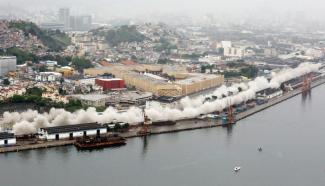


Overview
A 4.7-kilometre-long overpass is demolished in Rio de Janeiro. In its place, a new mobility study that includes 28 kilometres of light railway, 17 kilometres of cycle paths, pedestrianised zones and tunnels for cars travelling through the area.
The overpass in question, Perimetral, cut through the centre of Rio de Janeiro, contributing to the emptying out and degradation of the district, which, despite its central location, has the lowest population density in the city. Perimetral was built in the 1950s, the height of the country’s roadbuilding era, when planners’ primary concern was to facilitate the circulation of private cars.
The demolition of the first section of Perimetral on 24 November 2013 could be seen as representing a turning point in the way cities are conceived in Brazil. However small a step it may be, it has sparked a wave of discussions about city planning that have attracted a growing number of architects and urbanists.
As we update this cultural mapping on architecture and urbanism, we will review what has happened in Brazil from 2011 to 2015. Cities – and how they are built – are now increasingly present in the public debate. Indeed, architects are starting to take new positions and broadening the scope of the profession by taking a more proactive stance towards the country’s urban issues and challenges and devising new initiatives in keeping with the latest trends in the self-made city.
In this four-year period, architecture has also seen the passing of some of its most illustrious figures, including Oscar Niemeyer and João Filgueiras Lima (Lelé). But it has also gained in the form of its own council, CAU, which is the entity by which this profession is now regulated and represented, distinct from the engineering council.
Meanwhile, there is also growing number of foreign architects designing and erecting buildings in the country. Zaha Hadid, Richard Meier, Herzog & de Meuron, Daniel Libeskind and Santiago Calatrava are a few of the “starchitects” that have buildings of their design under construction here, especially in São Paulo and Rio de Janeiro, the latter of which will host the International Union of Architects World Congress in 2020.
Continue reading Mapping Brazil - Architecture: Urbanism